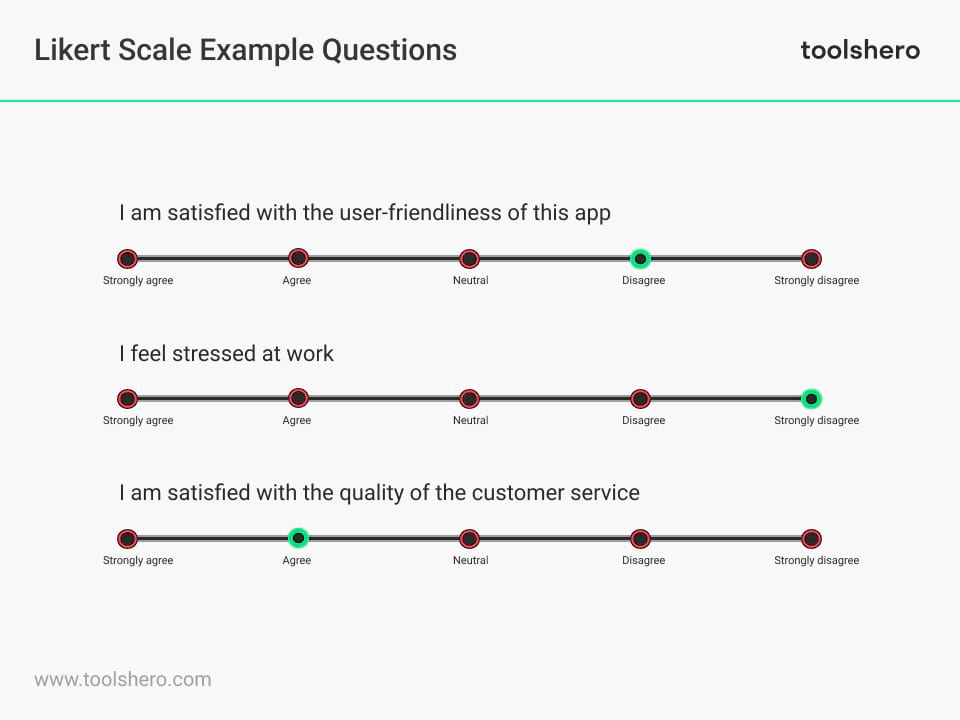Likert Scale Survey: Definition, Basics and Questions

Likert scale: this article explains the term Likert scale in a practical way. The article begins with the definition of this term, followed by a general explanation of this scientific concept. You can read more about the origin of the method, examples and practical tips for use in practice. Enjoy reading!
What is the Likert scale?
Definition of the Likert scale
A Likert scale is a rating scale used to measure opinions, attitudes or behaviors in surveys.
It consists of a statement or question, followed by a series of five or seven answer options. Respondents then choose the option that best reflects how they feel about the statement or question.
Because respondents are presented with a range of possible answers, Likert scales are suitable for capturing the level of agreement or feelings about the topic in a more nuanced way.
Likert scales are sensitive to response behavior. This is behavior in which respondents only agree or disagree with the statement because they are tired, because of social desirability or a tendency to give extreme reactions or other characteristics of the situation.
These scales are widely used in survey research, in fields such as marketing, psychology, or other social sciences.
How do I recognize a Likert scale?
Likert scales usually consist of a set of answers of five or seven options. The options at the tail-ends are called response anchors.
The midpoint is often a neutral item, with positive options on one side and negative options on the other. Each item is assigned a score of 1 to 5 or 1 to 7.
For example, the format of a five-level Likert scale question might be:
- Strongly disagree
- Disagree
- Neither agree nor disagree
- Agree
- Totally agree
In addition to measuring the level of agreement or disagreement, Likert scales can also measure other aspects, such as frequency, satisfaction or importance.
When are Likert scale questions used?
Researchers often use Likert scale questions when they want to add more nuance than a simple yes or no question can.
An example. Let’s say you’re conducting a survey about customer opinions about a pair of running shoes. You ask the survey respondents: Are you satisfied with the shoes you bought?
The answers to that question are:
- Yes
- No
This is called a dichotomous question. The answer to a dichotomous question provides very limited information. It is not possible to determine how satisfied or dissatisfied customers are exactly.
By asking a question using the Likert scale, a researcher gets more specific and interesting information.
Example question: “How satisfied are you with the shoes you bought?”
- Very dissatisfied
- Dissatisfied
- Insecure
- Satisfied
- Very satisfied
These scales are most useful when measuring non-observable individual traits, or traits that are not about objective measurements. These can be things like attitudes, feelings, or opinions that cause variations in behavior.
Research Methods For Business Students Course
A-Z guide to writing a rockstar Research Paper with a bulletproof Research Methodology!
Origin of the Likert scale
The Likert scale was developed by Rensis Likert in the 1930s.
It is a rating scale to measure attitudes and opinions. The scale provides standardized response options, making subjective information quantifiable. It is widely used in research and surveys to gain deep insight into attitudes and behaviors.
The Likert scale has influenced the way information is collected and measured and is used in various fields such as psychology, sociology, marketing and management.
The original Likert scale consisted of four response options:
- Agree
- Disagree
- Neutral
- No opinion
More options were added later, such as strongly agree and strongly disagree. Today, Likert scales usually consist of five or seven response options.
How do I create Likert scale questions?
Follow the steps below to create questions using the Likert scale.
Step 1: rate a single attitude or trait
Make sure each Likert scale question focuses on measuring one specific aspect of the topic. This prevents confusion. More importantly, it delivers accurate results.
For example, when evaluating attitudes toward environmentally friendly behavior, design questions that address different facets of this topic.
Example: To what extent do you agree with the statement: ‘I am willing to recycle plastic bottles’?
Step 2: combine questions and statements
To keep participants engaged, use a combination of questions and statements throughout the questionnaire. Make sure the wording is clear and does not introduce bias.
Example: Question: How important do you consider reducing carbon emissions?
Statement: It is essential to take measures to reduce carbon emissions.
Step 3: use positive and negative formulations
Avoid using socially desirable statements. This is important because respondents may tend to agree.
Use both positive and negative statements to maintain objectivity and assess reliability.
Example:
Positive statement: I believe in the importance of renewable energy sources.
Negative statement: I do not believe in the effectiveness of renewable energy sources.
Step 4: avoid double negatives
Double negatives can confuse respondents and lead to misinterpretation.
Use clear language to ensure clarity and accurate answers.
Example:
To what extent do you agree or disagree with the statement: ‘I do not disagree with the proposed environmental policy’?
Step 5: ask only one thing at a time
Avoid questions that combine multiple topics. As a result, respondents may get confused and misinterpret the question. Each question should focus on one aspect to collect data.
Example: How satisfied are you with the product quality and customer service?
Step 6: be crystal clear
Clear and unambiguous language is important for accurate data collection. Therefore, avoid professional jargon and use words that do match your target group. Leave no room for misunderstandings.
Example:
Statement: “The user-friendliness of the website is reasonably good.”
By following the steps above you can create strong Likert scale questions and use them in a survey.
Advantages and disadvantages of Likert scales
Likert scales are a practical and accessible method of collecting data.
Quantitative
Likert scales make complex topics easily measurable by breaking abstract phenomena into observable chunks. This allows the testing of hypotheses.
Detailed
Because Likert questions are not binary (yes/no, true/false, etc.), you can get detailed insights into perceptions, opinions, and behaviors.
User friendly
Unlike open questions, Likert scales are closed questions that do not require respondents to develop their own ideas.
This makes it quick and easy for respondents to complete and ensures that data can easily be obtained from large samples. It is important to make the threshold as low as possible to get the question answered.
Problems with Likert scaling often arise from inappropriate design choices.
Response bias
Because of socially desirable behavior, people often avoid selecting the extreme items or disagreeing with statements in order to appear more normal.
Fatigue / inattentiveness
Likert scales with many questions can cause respondents to become bored and lose interest. They may mindlessly select answers regardless of their actual feelings. This leads to invalid answers.
Subjective interpretation
Some items may be vague and interpreted very differently by respondents. Words such as “somewhat” or “reasonably” do not have precise or narrow definitions.
Limited choice
Because Likert questions are closed questions, respondents sometimes have to choose the most relevant answer, even if it may not accurately reflect reality.
Tips for working with Likert scale questions
Use an even number of answer options sometimes
When designing Likert scale questions, it is sometimes better to use an even number of answer options, such as 4 or 6. This avoids a neutral option in the middle and forces respondents to express a positive or negative attitude towards the statement.
Use clear and specific wording
Formulate the questions and answer options as clearly and specifically as possible. Avoid vague terms and make sure respondents can clearly understand the meaning of each answer option. This helps in getting accurate and consistent answers.
Vary the direction of the wording
To reduce bias, it is helpful to include both positive and negative wording in your Likert scale questions.
Combine Likert scale questions with essay questions
Likert scales can sometimes be limited in understanding the reasons behind attitudes or opinions.
To gain a deeper insight, you can supplement these type of questions with open questions in which respondents can explain their answers. This provides more context and qualitative information.
Now it’s your turn
What do you think? Do you recognize the explanation of the Likert scale? Have you ever used these in research? What do you think of this method of measuring attitudes and characteristics? What disadvantages or challenges have you experienced using this scale? Do you have examples of interesting applications of these scales in your field or area of interest? Do you have other tips or comments?
Share your experience and knowledge in the comments box below.
More information
- Allen, I. E., & Seaman, C. A. (2007). Likert scales and data analyses. Quality progress, 40(7), 64-65.
- Barick, R. (2021). Research Methods For Business Students. Retrieved 02/16/2024 from Udemy.
- Jebb, A. T., Ng, V., & Tay, L. (2021). A review of key Likert scale development advances: 1995–2019. Frontiers in psychology, 12, 637547.
- Joshi, A., Kale, S., Chandel, S., & Pal, D. K. (2015). Likert scale: Explored and explained. British journal of applied science & technology, 7(4), 396.
How to cite this article:
Janse, B. (2023). Likert Scale Survey. Retrieved [insert date] from Toolshero: https://www.toolshero.com/research/likert-scale/
Original publication date: 07/19/2023 | Last update: 04/11/2024
Add a link to this page on your website:
<a href=”https://www.toolshero.com/research/likert-scale/”>Toolshero: Likert Scale Survey</a>













